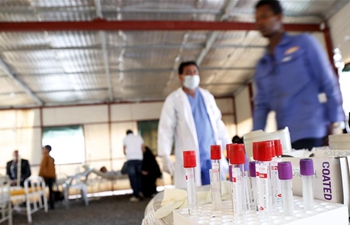WASHINGTON, Sept. 1 (Xinhua) -- A new study published in the latest issue of Science showed that genetic mutations in a form of non-small cell lung cancer may drive tumor formation by blurring cells' perception of key growth signals.
The research, led by University of California San Francisco (UCSF) scientists, could have important implications for understanding and ultimately targeting the defective mechanisms underlying many human cancers.
Healthy cells rely on the central Ras/Erk growth signaling pathway to interpret external cues about how and when to grow, divide, and migrate.
But defects in how these messages are communicated can cause cells to grow out of control and aggressively invade other parts of the body, according to the researchers.
Such mutations are found in the majority of human cancers, making treatments for Ras/Erk defects a "holy grail" of cancer research.
Using a high-throughput technique developed at UCSF that allows scientists to take control of Ras/Erk signaling using pulses of light, and then quickly read out resulting genomic activity, they have made a surprising discovery about this extensively studied pathway.
The new research had revealed that some Ras/Erk mutations might trigger cancer by altering the timing, rather than the intensity, of cellular growth signals.
The study also showed that this blurring of signal timing might explain why some targeted drugs designed to shut off defective Ras/Erk signaling could paradoxically activate the pathway instead potentially raising the risk of new tumor formation.
"This new technique is like a diagnostic instrument that we hook up to a diseased cell, which lets us stimulate and interrogate the cell with many light-based stimuli to see how it responds," said UCSF synthetic biologist Wendell Lim, one of the study's senior authors.
"Using this approach, we were able to identify cancer cells that have certain defects in how they process signals, behaviors that lead to cell proliferation in response to signals that normally are filtered by the cell circuits."
The Ras/Erk pathway is complex, but at its core is a cascade of four proteins (Ras, Raf, Mek, and Erk) that activate one another like a chain of falling dominoes in response to growth signals from outside the cell.
Ras sits at the cell membrane and receives incoming signals, then passes them along to Raf and Mek, which process and amplify them, until finally Erk transports the signal into the cell nucleus, where it can activate the appropriate genetic programs.
To track cells' responses to different patterns of Ras activation, the researchers engineered a system into multiple lines of healthy and cancerous cells, and placed different groups of these cells into an array of small wells in a laboratory dish.
They stimulated hundreds of different experimental groups of cells with a variety of test patterns, and simultaneously read out their responses under a microscope.
These techniques revealed that healthy cells respond selectively to long-lasting growth signals, while ignoring signals that flicker on and off, considering them to be irrelevant "noise."
In contrast, the researchers found that certain non-small cell lung cancer cell lines appeared to misinterpret these intermittent noisy signals as stronger, sustained signals, triggering excessive growth and tumor formation.
This misreading of signals appeared to occur because a specific type of mutation in the protein B-Raf corrupted the timing of incoming growth signals, causing short pulses of Ras activation to reverberate for longer within an affected cell.
"There may be future diagnostic and therapeutic opportunities that leverage the ability to detect aspects of signal corruption on a functional level that are not apparent by merely sequencing the cancer genome with the descriptive approaches that are currently standard in the field," said Trever Bivona, UCSF medical oncologist and cancer biologist and the paper's co-senior author.

















